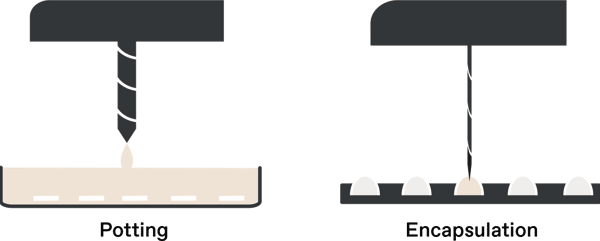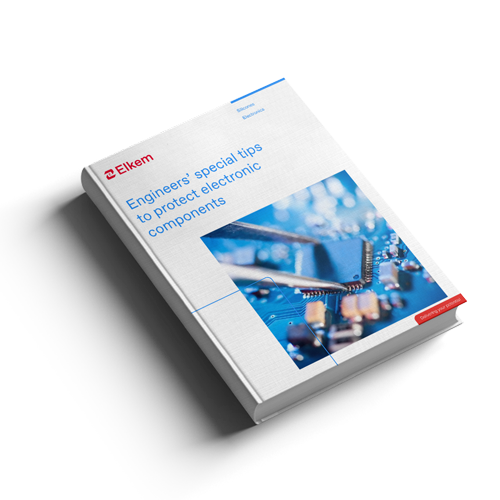- Magazine
- Mobility & transportation
- 8 benefits you probably didn’t know about encapsulation & potting electronics
8 benefits you probably didn’t know about encapsulation & potting electronics
This article is primarily addressed to electrical and electronics engineers in all industries who are involved in designing, producing and protecting critical electrical and electronic components. It examines current and future encapsulation and potting technologies that protect sensitive electrical and electronic components against major threats: shocks, vibration, moisture, corrosive agents, extreme temperatures, cracking, corrosion ageing, etc.
This study also provides key information for non-specialist decision makers, including Executive Managers, Industrial and Procurement Managers, as well as Financial Officers or Marketing and Salespeople, to enable them to understand how encapsulation and potting technology works and how it can improve performance, ensure safety and security for a great diversity of applications and markets and contribute to their competitiveness.
In this blog, we look at encapsulation and potting, while other related blogs will examine conformal coating and, subsequently, thermal management. This series strives to give our readers the fullest overview of available and emerging technologies to protect their electronic products efficiently.
Why is it more important than ever to efficiently protect critical electrical and electronic parts?
From miniature personal devices to immense ocean-going vessels and automated industrial plants, electronics are enabling us to improve people’s lives globally and produce better products and services, which must be increasingly well protected. This is particularly true when used in products that can cannot fail, such as electrically powered transport vehicles to avoid risk to people’s lives and safety. Electrification is also the key to reduce our carbon imprint, pollution and our dependency on fossil fuels. In short, durable and properly protected electronics are the key to countering global warming and controlling climate change for a sustainable future.
What is potting and encapsulation in electronics?
Potting and encapsulation are the two main techniques used to protect sensitive and critical electronic components from diverse threats, such as harsh environmental and climatic conditions, corrosive chemical aggression, vibrations, dust, exposure to heat and fire. They work alongside other protective techniques, such as conformal coating and sealing and bonding.
To begin with, let’s look at the difference between the two techniques. Potting is the process of filling (partially or completely) or embedding the electronic component or assembly in an enclosure with a resinous material such as silicone for the purpose of providing protection. The formulations used can also contribute to improve electrical insulation, flame retardancy and heat dissipation.
Encapsulation is a similar process to potting but differs because the component is generally dipped into a mold and then placed in a space, without necessarily filling the entire cavity. The purpose of encapsulation is therefore to create a protective “shell” around the component, without embedding it. It provides resistance to major threats, such as shock, vibration, moisture, corrosive agents and improves electrical insulation, flame retardancy and heat dissipation.
The advantage of encapsulation, when it is possible in the assembly, is that components can be more accessed for repair or more easily replaced because they is not permanently integrated into the final part.
To pot or to encapsulate, that is the question.
The key to determining whether potting or encapsulation is best for an application is based on several factors, including the operating and environmental conditions of the final product, the physical properties required for the materials being used and the processing requirements and capacities of the manufacturer.
Silicones are increasingly the materials of choice for potting or encapsulating sensitive electronics such as sensors, actuators, central processing units (CPUs), printed circuit boards (PCB) and other assemblies, largely because of their excellent wetting capabilities, which minimize air pockets and other imperfections.

What are the different materials that can be used for potting and encapsulation?
Let’s look at the various materials used for electronic potting and encapsulation.
In the past, conventional materials such as glass, metals and ceramics were used for electrical protection and were gradually replaced by polymers (homopolymers, copolymers, composites, complexes, blends of small molecules, and alloys). This shift has come about because these new materials offered new and highly diversified molecular characteristics to protect new generations of electronic, microelectronic, and nanoelectronics systems.
They improved the performance of final products, but also contributed to streamlining processing, reducing weight and volume, as well as offering greater versatility for protecting complex and miniaturized parts, ultimately enhancing quality, durability and cost-effectiveness.
One of our internal experts sums up the fast pace of change in electronics and how important it is to remain agile and work collaboratively:
“When one considers how quickly electronics are evolving and how, every day, new applications are being developed in dozens of industries and thousands of specific products or systems, it is important to examine options with experts and take no possibility for granted. Silicones are indeed increasingly a material of choice because of the huge range of possible formulations and features, but they must be carefully considered and tested, both in terms of processing and end user benefits. Silicone R&D specialists, process engineers and product developers must therefore work hand-in-hand to align their needs and implement efficient future-proof solutions. The key words to achieve this are: agility and collaboration.”
What are the main benefits of potting and encapsulation and what materials are best suited?
Today, three types of materials dominate this field: silicones, epoxy resins and polyurethanes. In the table below, we list and compare their intrinsic features:
| Silicones | Epoxy Resins | Polyurethanes | ||
| Temperature range and elasticity | Heat resistance | Good | Poor | Poor |
| Temperature range, °C | -50 to 200 | -50 to 150 | -30 to 120 | |
| Elasticity | Elastomer - Gel | Rigid resin | Rigid resin - Elastomer | |
| Strength, adhesion and resistance features | Modulus | Low | High | High |
| Mechanical strength | Medium | Strong | Strong | |
| Adhesion strength | Medium - High | High | Medium | |
| UV Resistance | Excellent | Poor | Poor | |
| Ozone stability | Good | Poor | Poor | |
| Ionic Impurities | Minimal | Medium | Medium | |
| Flame retardancy and dielectric behavior | Flame retardancy* | Self-extinguishing | Non-Self-extinguishing | Self-extinguishing |
| Dielectric stability | High | Medium | Low | |
| Coeff. Therman Exp. | High | Low | Medium | |
*As a base material, silicone demonstrates flame retardant properties comparable to UL94-V0
Eight areas where silicones outperform epoxies or polyurethanes in potting and encapsulation:
- Heat resistance, temperature range – silicones offer better heat resistance, temperature range (-50° to 200°C and up to 300°C in some formulations)
- Flame retardancy – Silicone is self-extinguishing, which is not the case for epoxies or polyurethanes.
- Thermal expansion – due its low hardness, silicone offers greater linear thermal expansion coefficients of approx. 3 × 10-4 m/(m K), much higher than other polymers.
- Elasticity –Silicone elastomers are particularly elastic because they are compounded using reactive, straight-chained molecules together with a cross-linking agents and reinforcement.
- Resistance to environmental hazards – silicones outperform all other potting and encapsulation materials in this category, in particular moisture and UV resistance, as well as ozone stability. These features, as well as heat resistance and a high temperature range (mentioned above) make silicones an ideal material for electronic systems in harsh environments.
- Vibration– in industrial applications, silicones offer great resistance to vibrations because they are softer and more flexible (low modulus). With their capacity to endure temperature changes and protect against corrosive substances, silicone are especially well suited to demanding closed spaces such as engine housings or turbines.
- Dielectric stability – silicones offer both excellent electrical insulation and sufficiently constant conductivity over a wide temperature and frequency range.
- Repairability – Silicones can be dissolved with solvents when necessary for reworking or repairing specific components.
Four areas where epoxies or polyurethanes offer alternative features in potting and encapsulation:
- Mechanical strength – this is a plus for epoxy and polyurethanes, but in some cases, silicone has sufficient resistance. This must be determined in terms of end user needs.
- Modulus –This is the measure of a material returning to its original form after having been deformed. The lower the modulus, the more quickly the material returns to its initial shape. Silicones have lower modulus than the other two materials. This can be a plus or a minus, depending on the application. Both epoxy resins and polyurethanes present higher shear modulus than silicones, which are important features in hard and resistant systems but can be a drawback when re-workability and ease of processing are the awaited benefits.
- Adhesion strength – epoxy resins provide the highest level of adhesion strength in bonding, but silicones and polyurethanes provide medium to high adhesion, sufficient for most applications. Epoxies generally possess the strongest bonding strength of the three materials, but silicone adhesion can be modified and optimized to stick to various substrates and offer more flexibility once they have been cured.
- Hardness – epoxies are generally harder than silicones after curing, which can be a drawback or an advantage depending on the application.
Readers should keep in mind that, in certain assemblies, a mix of these three technologies is possible, considering ease of processing, critical performance criteria for the final product and cost-effectiveness.
Furthermore, both epoxy resins and polyurethanes present higher shear modulus than silicones, which are important features in hard parts but can be a drawback for repairability.
Are silicone-based conformal coatings safe and sustainable?
To meet environmental and health concerns, silicones use less solvents, which have also been modified to radically decrease their content of VOCs (Volatile Organic Compounds). In some new and innovative formulations, certain silicones have become completely solvent-free and cure in a very short time, without sacrificing any of their low modulus. This ongoing research is being done with manufacturing and process specialists in many industries.
Silicone-based potting and encapsulation formulations are in conformity with the highest standards and are subjected to strict tests to ensure long product life and increased repairability and recyclability.

